Most of this key is reduced from published works that include many more species
than occur in the Ottawa District, primarily from E.M.Walker, 'The Odonata of Canada
and Alaska'. I also consulted in detail J.G.Needham & M.J.Westfall, 'A Manual of the
Dragonflies of North America'; A.Robert, 'Les libellules du Québec'; and R.Hutchinson
& A.Larochelle, 'Manuel d'identification des Libellules du Québec'.
In the reduction, I favoured terms that are visible on a living insect. Each term of the key
was verified using all applicable specimens in the Canadian National Collection of
Insects (Ontario & Quebec, excluding the far north). The field-mark oriented sections
marked by § symbols are my own, are based solely upon living insects within
the Ottawa District, and appear only in cases where I am certain that
they are significantly more reliable in the field here than the specimen-based key.
I welcome suggestions for additional field marks.
| 1 | fore and hind wings similar; eyes separated by more than
their own width | Zygoptera 2
|
| hind wing broader than forewing | Anisoptera 11
|
| 2 | Zygoptera: damselfiles
|
| wings not stalked at base, many crossveins before
nodus | Calopteryx 3
|
| wings stalked at base, two crossveins before nodus | 2a
|
| 2a | wings held spread open when resting; vein M3 rises from M1-2
closer to arculus than to nodus | Lestes 4
|
| wings held together above back when resting; M3 rises behind
nodus | Coenagrionidae 5
|

|
| 3 | Calopteryx: unstalked broad wings held together above back when
resting |
| § male: wing all clear, female: wing diffuse colour to beyond
nodus, end clear; 3Jun-2Sep | C.aequabile
|
| § male: wing all dark, female: wing all smoky with white spot at
stigma; 27May-10Sep | C.maculata
|
| 4 | Lestes male
|
| lower appendages much less than half the length of upper; thorax dark
metallic green, wings yellowish 27May-28Jun | Lestes eurinus
|
| lower appendages half or a bit less the length of upper; thorax nearly
black 9Aug-13Oct | L.congener
|
| lower appendages longer than upper, ends curved in; metallic green
30May-8Aug | L.inaequalis
|
| lower appendages S-curved with divergent ends; blue eyes yellow
lower lip black thorax 8Jun-9Sep | L.unguiculatus
|
| upper appendages meeting at acute angle; dark metallic green
16Jun-27Aug | L.vigilax
|
| abdomen very long and slender; hairy green lower lip, 15Jun-
10Sep | L.rectangularis
|
| thorax metallic green above yellow sides; stout,
30May-25Aug | L.dryas
|
| segment 2 3/5 as long as 3, rear tooth of upper appendages blunt, much
smaller than front one; blackish, greenish face 6Jun- 21Sep | L.forcipatus
|
| segment 2 1/2 as long as 3, rear tooth of upper appendages acute, as
large as front one; blackish, greenish face 2Jul-21Sep | L.disjunctus
|
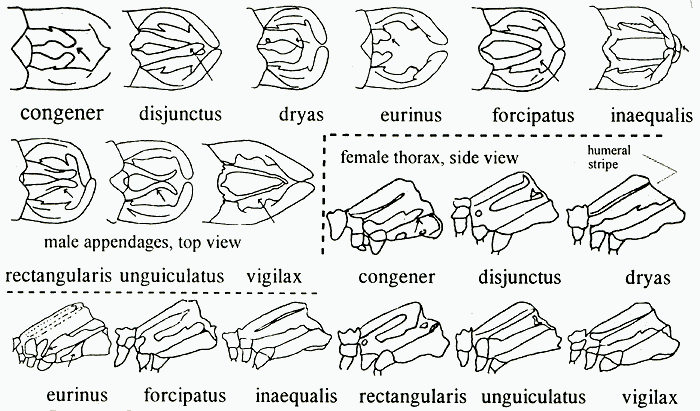
|
| 4a |  Lestes: female
Lestes: female
ovipositor 1/2 or less as long as segment 7
ovipositor as long as segment 7
|
4b
4c
|
| wing yellowish | L.eurinus
|
| thorax dark brown, narrow pale yellow stripe | L.congener
|
| dark areas of abdomen bronzy colour | L.disjunctus
|
| these areas greenish | L.unguiculatus
|
| 4b | grey humeral stripe more than 1/2 as wide as dark brown stripe
above; fewer than 14 postnodal crossveins | L.rectangularis
|
| reddish-brown humeral stripe 1/3 or more thickness of metallic stripe
above | L.vigilax
|
| this stripe yellowish, less than 1/4 thickness of stripe
above | L.inaequalis
|
| 4c | thorax metallic green, stripe clear yellow | L.dryas
|
| thorax dull bronze-brown, stripe pale yellow | L.forcipatus
|
| 5 | Coenagrionidae:
|
| leg hairs twice as long as the space between them | Argia 6
|
| leg hairs only a bit longer than the space between them | 5a
|
| 5a |  two spots on top back of head next to eye
two spots on top back of head next to eye
no such spots
| 5b
5d
|
| 5b | M2 arises near the 4th crossvein after the nodus in forewing, between
2nd & 3rd vein in hindwing | Ischnura 7
|
| M2 arises near the 5th crossvein after the nodus in forewing, near the
4th vein in hindwing | 5c
|
| 5c | male: lower appendages with notch when viewed from side, female:
segment 8 without spine on bottom | Coenagrion 8
|
| male: lower appendages triangular when viewed from side, female:
segment 8 with spine on bottom rear | Enallagma 9
|

|
| 5d | body only red and black; small 1Jun-8Aug | Amphiagrion saucium
|
| body blue & black with bright sulphur yellow stripe on thorax rear;
7Jun-4Aug | Chromagrion conditum
|
| § thorax metallic green top blue bottom, abdomen blue (male)
blue-green (female) with black areas all the way to segment 10; 1Jun-28Aug | Nehalinnia irene
|
| § as N.irene but no black on segments 9 or 10;
30May-12Aug | N.gracilis
|
| 6 | Argia: argos = bright (coloured)
|
| upper parts of segments 3-6 black-brown; 7Jun-12Sep | Argia moesta
|
| violet-blue; 19Jun-19Aug | A.fumipennis
|
| 7 | Ischnura: ischnos = thin, oura = tail
|
| two narrow long shoulder stripes; 5May-15Oct | Ischnura verticalis
|
| two exclamation marks on shoulder; 4Jun-9Sep | I.posita
|

|
| 8 | Coenagrion: agrios = field
|
| two long shoulder stripes; 12Jun-29Jul | Coenagrion resolutum
|
| two wide exclamation marks on shoulder; (Muskoka
3Jun-25Jul) | C.interrogatum
|
| 9 | Enallagma male: enallex = crosswise (striped)
|
| black of segments 3-4 less than 2/3 length of segment; pale blue | 9a
|
| this black more than 4/5 length of segment | 9c
|
| 9a | upper appendages longer than lower, a pale bump on upper
end | 9b
|
| upper appendages clearly split in two; 30May-24Aug
| Enallagma ebrium
|
| upper appendages short and rounded; 16May-24Jul | E.boreale
|
| upper appendages slender with points curved up;
30May-21Aug | E.hageni
|
| upper appendages with prominent tooth/ridge;
29May-27Jun | E.cyathigerum
|
| 9b | upper appendages symmetrical viewed from side;
18May-20Sep | E.carunculatum
|
| upper appendages asymmetrical; 6Jun-12Sep | E.civile
|
| 9c | upper appendages tapered to slender upturned points;
15Jun-3Sep | E.geminatum
|
| upper appendages split in profile | 9d
|
| otherwise | 9e
|
| 9d | upper branch of upper appendages shorter than lower branch;
7Jun-19Sep | E.exsulans
|
| both these branches about equal; 9Jun-14Aug | E.antennatum
|
| 9e | upper appendages' height greater than 1/2 their length;
18Jun-29Aug | E.vesperum
|
| otherwise; 3Jun-9Sep | E.signatum
|
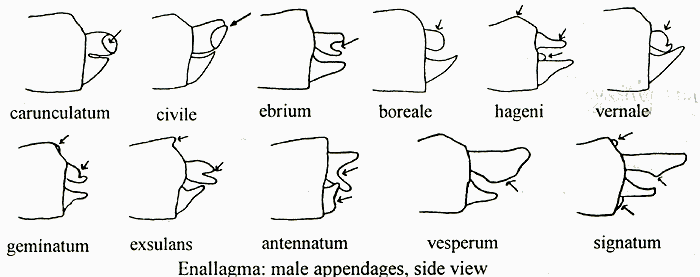
|
| 10 | Enallagma female (these are reliably separable only by microscopic
examination of thorax plate)
|
| segment 8 with pair of large blue spots | E.geminatum
|
| segments 8-10 entirely black above | E.hageni or E.ebrium
|
| segments 7,8,9 with similar marking | E.civile or E.carunculatum
|
| segment 8 entirely black, 9 or 10 not; eye spots elongated to or almost
to occiput | 10b
|
| segment 8 black only on rear half or all pale | 10a
|
| 10a | fine line between spots of segment 8 | E.boreale
|
| these spots separated by a line at front, a wider gap at rear, side spots
reach top of segment 10 | E.cyathigerum
|
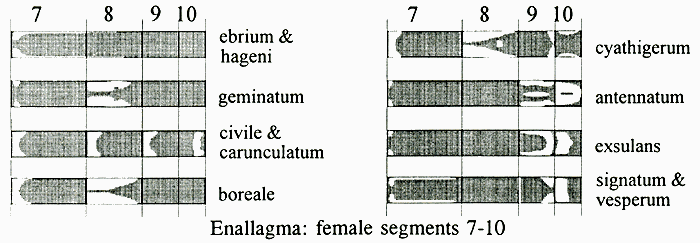
|
| 10b | black humeral stripe twice or more width of pale stripe
above | 10c
|
| black stripe about same width or narrower | 10d
|
| 10c | black stripe divided by pale line | E.exsulans
|
| not so divided | E.antennatum
|
| 10d | pale stripe with gap in middle; M2 begins between crossveins 4-
5 | E.vesperum
|
| no such gap; M2 begins between crossveins 5-6 | E.signatum
|

|
| 11 | Anisoptera:
|
| eyes separated by about half their width | Gomphidae 17
|
| eyes touching on top of head or separated by only a tiny fraction of
their width | 11a
|

|
| 11a | triangles about equally distant from arculus in both wings, both
oriented lengthwise on wing | Aeshnoidea 12
|
| triangle at least twice as far from arculus in forewing as in hindwing,
forewing triangle oriented across wing, hindwing lengthwise | Libelluloidea 22
|
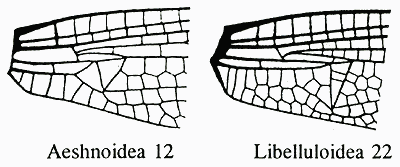
|
| 12 | Aeshnoidea:
|
| eyes barely touch at top or slightly separated | Cordulegaster 21
|
| eyes meet in seam at least height of occiput | Aeshnidae 13
|
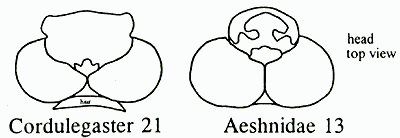
|
| 13 | Aeshnidae:
|
| medial space with more than 1 crossvein; 2 rounded pale spots on
thorax sides, yellow stigma | Boyeria 14
|
| with one crossvein or none | 13a
|

|
| 13a | sectors of arculus arising from its upper end, thorax uniform green;
21Apr-15Oct | Anax junius
|
| sectors of arculus arising near its middle, thorax brown | 13b
|
| 13b | Rs vein not forked; 3 or more cubito-anal cross veins, blue body
with bright yellow strips on thorax sides 8Jun-17Jul
| Basiaeschna janata
|
| stalk of Rs vein with symmetrical fork | 13c
|
| stalk of Rs vein up-arched and fork askew forward | Aeshna 15
|

|
|
13c | radial planate subtends 1 row of cells; very prominent blue frons, face yellowish
margined with brown 20Jun-16Jul
| Nasiaeschna pentacantha
|
| subtends more than 1 row at least basal half; largest Odonata here,
brown & green, 7Jun-9Sep | Epiaeschna heros
|
| 14 | Boyeria: fly until well after dusk
|
| wing base completely clear; side spots of thorax grey-bluish, segments
9 & 10 similar in colour, body grey-brown 27Jun- 7Oct | Boyeria grafiana
|
| wings with brown spots at base (usually small); 2 clear yellowish
thorax side spots, segment 10 more yellow than 9, body brown, 5Jul-22Sep | B.vinosa
|
| 15 | 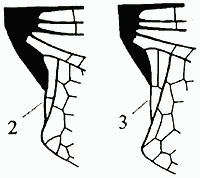 Aeshna, male:
Aeshna, male:
anal triangle with 3 cells; 2 yellow to green stripes on thorax
with 2 cells
|
15a
15b
|
| 15a | rear of head marked with yellow or brown, row of pale spots each
side of segments 4-6; some green on segments 5-10, 12Jun-21Oct
| Aeshna umbrosa
|
| rear of head black, no such spots; 19Jul-11Oct | A.constricta
|
| 15b | 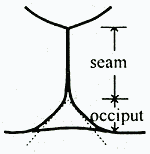 central thorax stripe 1 mm or less wide and bent in sharp Z; eye
seam little if any longer than occiput, greenish face, T-spot with crescent base (Tremblant
21Jun-14Sep)
central thorax stripe 1 mm or less wide and bent in sharp Z; eye
seam little if any longer than occiput, greenish face, T-spot with crescent base (Tremblant
21Jun-14Sep)
central stripe not bent sharply, more than 1 mm wide; eye seam at least 2x
length of occiput | A.sitchensis
15c
|
| 15c | central and lower thorax stripes interrupted, reduced to two elongate
spots or absent; yellow head, dark body 2Jul-1Oct
| A.interrupta
|
| these stripes wider, generally full length | 15d
|
| 15d | face with fine but clear black-grey stripe on face suture | 15e
|
| stripe not clear, more like a shadow than a marking; upper side of upper
appendages hairy | 15f
|

|
| 15e | large pale spots between green side stripes of thorax, sometimes
confluent with central stripe; 5 paranal cells, slender 19Jul-12Sep
| A.clepsydra
|
| spotted with blue; 4-5 paranal cells 19Jun-15Sep | A.eremita
|
| central thorax stripe clearly concave on front edge; 3-4 paranal cells
12Jul-10Sep | A.subarctica
|
| central thorax stripe convex on leading edge (may be only slightly); 3-4
paranal cells 14Jul-31Aug | A.juncea
|
| 15f | segment 10 all black; large thorax stripes 27Jul-22Sep
| A.tuberculifera
|
| pale spots on dorsum of segment 10 | 15g
|
| 15g | central thorax stripe mostly or all blue;
21Jun-27Sep | A.canadensis
|
| this stripe all green; 14Jul-11Aug | A.verticalis
|
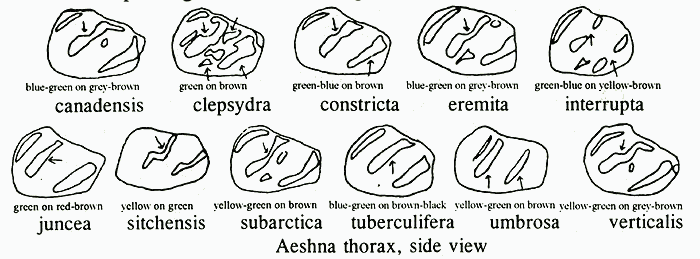
|
| 16 | female:
|
| central thorax stripe 1 mm or less wide and bent in sharp Z; eye seam
little if any longer than occiput, greenish face, T-spot with crescent base | A.sitchensis
|
| central stripe not bent sharply, more than 1 mm wide; eye seam at least
2x length of occiput | 16a
|
| 16a | palp of ovipositor (see 4a) as long as segment 10 | 16b
|
| palp much shorter than segment 10 | 16c
|
| 16b | front edge of central thorax stripe nearly straight; thin pencil of
hairs at end of vulva | A.tuberculifera
|
| this edge distinctly sinuate; no such pencil of hairs | A.constricta
|
| 16c | face with black line on face suture | 16d
|
| any such line indistinct | 16f
|
| 16d | central and rear thorax stripes interrupted, reduced to two elongate
spots or absent | A.interrupta
|
| these stripes well developed | 16e
|
| 16e | front thorax suture with large triangular pale spot
below | A.clepsydra
|
| 4-5 paranal cells; spotted with green 19Jun-15Sep | A.eremita
|
| central thorax stripe concave on front edge; 3-4 paranal cells
| A.subarctica
|
| central thorax stripe convex on leading edge; 3-4 paranal cells
| A.juncea
|
| 16f | central thorax stripe straight, margined with blackish | A.umbrosa
|
| central stripe distinctly sinuate | 16g
|
| 16g | central thorax stripe mostly or all blue | A.canadensis
|
| this stripe all green | A.verticalis
|
| 17 | Gomphidae:
|
| triangles with a cross vein, each with a supplementary longitudinal vein
springing from its outer edge; very large, small head, black and greenish yellow, eats other
dragonflies 21Jun-21Aug | Hagenius brevistylus
|
| triangles clear, no such vein, rarely 65 mm long | 17a
|

|
| 17a | male: hind wings with anal loop, usually 3 cells, lower appendage
ends separated slightly, female: vulva nearly as long as the rear of segment 9 | Ophiogomphus 18
|
| male: without anal loop, lower appendage ends widely separated,
generally divergent, female: vulva usually less than half as long as the rear of segment 9 | 17b
|
| 17b | small, 25-40 mm long, stigma less than 4x as long as wide and more
than 2x as wide as the space behind its middle; greenish with lots of black 21Jun-14Aug
| Stylogomphus albistylus
|
| 42-65 mm long, stigma rarely less than 4x as long as wide, less than 2x
as wide as this space | 17c
|

|
| 17c | long hind legs reaching the base of segment 3 with 4-7 long spines
below; dark brown, distinctive pale green markings on thorax 5Jun-31Aug | Dromogomphus spinosus
|
| hind legs not reaching beyond the middle of segment 2, only short
spines | Gomphus 20
|
| 18 | 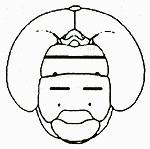 Ophiogomphus: male
Ophiogomphus: male
face striped across with black
face uniformly pale |
18a
18b
|
| 18a | upper appendages (top view) bowed, separated by a U-shaped space,
ends blunt, lower appendages nearly as long as upper; greenish with black- brown markings
20Jun-5Sep | Ophiogomphus colubrinus
|
| upper appendages triangular with straight edges, separated by a
V-shaped space, ends pointed, lower appendages shorter than upper; greenish with clear black markings
20Jun-2Aug
| O.anomalus
|
| 18b | black legs | 18c
|
| legs with extensor surfaces yellow; greenish with brown markings
20Jun-28Aug | O.rupinsulensis
|
| 18c | lower appendages much shorter than upper and not projecting out to
sides beyond them; greenish, brown markings on thorax 15Jun-11Aug | O.aspersus
|
| lower appendages little if any shorter than upper and projecting
sideways beyond them; yellowish green with brown markings 4Jun-7Jul | O.mainensis
|

|
| 19 | female
|
| face striped across with black | 19a
|
| face uniformly pale | 19b
|
| 19a | thorax without a dark central stripe; occiput without spines but with
a definite fringe of hairs, horns behind occiput stout | O.colubrinus
|
| thorax with dark central stripe; occiput with a pair of black spines, hair
not in fringe, horns behind occiput very small | O.anomalus
|
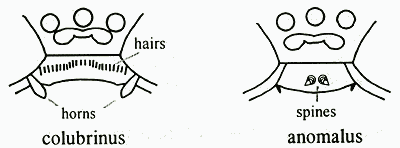
|
| 19b | horns behind occiput stout and conspicuous | O.rupinsulensis
|
| horns absent or small | 19c
|
| 19c | segments 8-9 without yellow spots; with a pair of high contiguous
occipital spines | O.mainensis
|
| segments 8 and 9 each with a yellow spot; occipital spines if present
small and well separated | O.aspersus
|
| 20 | Gomphus:
|
| face entirely yellow-green or olive | 20a
|
| face partly or entirely dark | 20g
|
| 20a | legs yellow on outside | 20b
|
| legs entirely black or brown | 20c
|
| 20b | male: upper appendages without spine under, female: occiput with
slightly convex margin fringed sparsely with hair, vulva less than 1/6th as long as segment 9 with lobes
widely separated; dull brown and green 14Jun-10Jul | Gomphus lividus
|
| male: upper appendages with obtuse protrusion under, female: occiput
slightly bilobed; dull yellow with pale brown thorax stripes 8Jun-12Aug | G.exilis
|
| male: upper appendages with spine under, female: occiput with a
central prominence and slight emargination on each side; dull greenish brown
24May-14Jul | G.spicatus
|
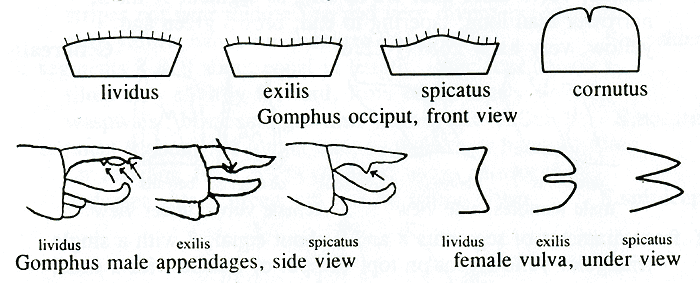
|
| 20c | occiput half height of eye, shape as G.lividus, fringed with long
black hair, male: upper appendages' ends convergent, slender and not meeting in middle, female: vulva
about 1/3 as long as segment 9, triangular with a short narrow cleft, no horns on vertex; greenish with black
markings 1Jun-17Aug | Arigomphus furcifer
|
| occiput height of eye, notched in middle, no hair protruding, male:
these ends meeting in middle, female: vulva as G.furcifer; yellowish green with brown and black markings
6Jun-27Jul | A.cornutus
|
| male: upper and lower appendages' ends parallel, directed rearward,
female: vulva less than 1/4 as long as segment 9, angle between the lobes obtuse | 20d
|

|
| 20d | segments 7-9 only slightly enlarged, the greatest width less than
twice the least width, 8 and 9 with scarcely any rim, edge of 8 straight in profile, 10 half as long as
9 | 20e
|
| segments 7-9 greatly enlarged, the greatest width more than twice the
least width, 8 and 9 with wide rim, edge of 8 convex in profile, 10 1/3 as long as 9 or less | 20f
|
| 20e | male: front hamules almost as long as rear, ending in a long slender
hook, female: vulva less than 1/2 as long as segment 9, about as wide as long, not tapering to end; clear
brown green and yellow 4Jun-30Jul | Gomphus descriptus
|
| male: front hamules much shorter than rear, rounded at end, female:
vulva more than 1/2 as long as segment 9, much narrower than long, tapering to end; brown green and
yellow, very hairy 26May-22Jul | G.borealis
|

|
| 20f | front diameter of segments 8 and 9 about equal, 8 with a single
triangular yellow spot on top, occiput of female with a small central hump; pale, hairy, wasp waist
1Jun-23Jul | G.fraternus
|
| diameter of segment 8 much greater than 9, 8 with two spots on top,
occiput of female without hump; green with bright brown markings, abdomen blackish, wasp waist
15Jun-14Jul | G.ventricosus
|

|
| 20g | upper pale thorax stripes flowing together with collar stripe | 20h
|
| these stripes isolated | 20i
|
| 20h | segments 7-9 as wide as thorax, 8 & 9 with wide curved side rims, 8
more curved than 9, 10 about a third as long as 9; thorax greenish yellow with bright brown markings,
abdomen blackish with yellow at front and back 1May-31Jul | G.vastus
|
| segments 7-9 much narrower than thorax, rim of 9 more curved than 8,
10 more than half as long as 9; yellowish green with strong black markings
7Jun-21Jul | G.adelphus
|

|
| 20i | abdomen not more than 1/7th longer than hind wing, male: rear
hamules leaning somewhat backward | 20j
|
| abdomen 1/5 to 1/3 longer than hind wing, male: rear hamules leaning
somewhat forward | 20k
|
| 20j | small, 32 mm abdomen 28 mm hindwing, pale yellow upper thorax
stripes near middle line only slightly divergent; darkish, late June | Stylurus amnicola
|
| large and robust, 40 mm abdomen 34 mm hindwing, these stripes not
near middle line and very divergent; blackish with yellow bands on abdomen
25Jun-9Sep | S.scudderi
|
| 20k | segments 8 & 9 about equal in length, male: rear hamules tilted only
slightly forward, front edges nearly straight; waspwaist, black and greenish yellow
7Jul-12Oct | S.notatus
|
| segment 9 about 1/4 longer than 8, male: rear hamules tilted far
forward, front edges concave; wings shorter than abdomen, black green and yellow
30Jun-16Sep | S.spiniceps
|
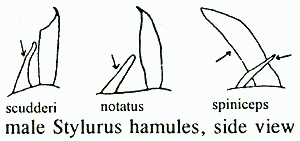
|
| 21 | Cordulegaster:
|
| single row of yellow abdominal spots on top; July
| Cordulegaster obliqua
|
| paired abdominal spots large, triangular and widely separated and eyes
separated by a small space on males, usually on females; female ovipositor barely longer than segments
9+10, 28May-14Jul | C.diastatops
|
| paired spots small, narrowly separated or confluent, rounded behind on
males usually on females, eyes meet at point; female ovipositor 2x length of segments 9+10,
29May-14Jul | C.maculata
|

|
| 22 | Libelluloidea:
|
| hind wing triangle about half as far from arculus as in forewing, anal
loop about as long as wide, its included cells not in 2 long rows, undeveloped radial and medial planates
| Macromiidae 23
|
| hind wing triangle at or very close to arculus, anal loop somewhat foot
shaped, divided lengthwise by a midrib into 2 rows of cells | 22a
|
| 22a | forewing triangle 1½ times as high as wide, anal loop with little if
any development of toe, males: well developed anal triangle | Corduliidae 29
|
| forewing tringle 2x as high as wide, anal loop with well developed toe
(except Nannothemis rear wing), male: no anal triangle | Libellulidae 24
|

|
| 23 | Macromiidae:
|
| occiput and vertex pale; nodus of forewing about equally distant from
stigma and wing base 23May-30Jul
| Didymops transversa
|
| occiput and vertex black; nodus of forewing clearly closer to stigma
than to wing base 15Jun-28Aug | Macromia illinoiensis
|
| 24 | 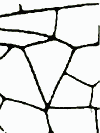 Libellulidae: Libellulidae:
forewing triangle with front side broken making a quadrangle of it; anal
loop of hind wing open rearward, smallest dragonfly here (wing 20 mm)
20Jun-9Aug |
Nannothemis bella
|
|  triple-length vacant space under stigma; (Lanark 11Jun-30Sep)
triple-length vacant space under stigma; (Lanark 11Jun-30Sep) | Pachydiplax longipennis
|
| vein M2 distinctly waved | 24a
|
| vein M2 smoothly curved | 24b
|

|
| 24a | wings with several bridge crossveins | Libellula 26
|
| single bridge crossvein, large brown spot on rear base of hind wing;
13Jul-10Sep | Pantala hymenea
|
| single bridge crossvein, no such spot; 11Jun-27Aug | P.flavescens
|
| 24b | brilliant three-colour wings: clear, yellow, brown | Celithemis 25
|
| wings almost clear | 24c
|
| 24c | vein Cu1 in hind wing arising from hind end of triangle
| Sympetrum 28
|
| arising from outer side, sometimes only by vein width | 24d
|

|
| 24d | forewing triangle inner side less than twice as long as front side,
stigma short and thick, face bone white (if not check Sympetrum 28) | Leucorrhinia 27
|
| inner side more than twice as long as front, stigma about 3 times as
long as wide, face greenish with brown hairs; radial planate subtends 1 row of cells (if 2 rows, it's
Pantala flavescens
24a), mostly greenish to grey-blue, brown spots in segments 3-9 19Jun-5Sep | Erythemis simplicicollis
|
| 25 | Celithemis: brilliant yellow and brown spots covering half or more of wings
|
| § 4 spots per wing, end one beyond stigma;
18Jun-23Aug | C.elisa
|
| § 5 spots per wing, end one inside stigma 15Jun-16Aug
| C.eponina
|

|
| 26 | Libellula: stout body shorter than wing span, medium size,
hunch-backed appearance both at rest and in flight
|
| § wing clear (may be smoky at tip); forewing triangle 3-celled,
eye seam longer than occiput, longer and slimmer than L.julia; 21Jun-14Aug | L.incesta
|
| § wings clear except for small dark basal spots; forewing triangle
2-celled, eye seam shorter than occiput; 7Jun-30Jul
[I am not certain that the wing basal spot can be used to separate julia from incesta - a
few females in the national collection have basal spots, eye seam shorter than occiput, but
3-celled triangles.] | L.julia
|
| § basal third of both wings covered full width by blackish band,
tips clear; 26Jun-30Aug | L.luctuosa
|
| § nodus wing band at rear wider than 1/5 hindwing length, no
spot at stigma, 28May-25Aug | male L.lydia
|
| § large clear separate basal, nodal and wing-end spots, forewing
basal colour does not extend into topmost cell of triangle, female | female L.lydia
|
| § as female L.lydia, but forewing basal colour extends into
topmost cell of triangle making a notch in its rear; normally longer wingspan than lydia, males have
prunescent spots on wings with age; 1Jun-28Sep | L.pulchella
|

|
| § hind wing with triangular yellow to brown spot at base with
white crossveins and dark rear border, small clear brown spot at nodus; usually yellow costal streak,
sometimes swarms 7May-28Aug | L.quadrimaculata
|
| 27 | Leucorrhinia: white face on black head; small, not stout, wings
mostly clear
|
| § all blackish except for prunescence; trigonal interspace of
forewing with two rows of cells inner third (other L. have 3 rows); 30May-21Aug | L.frigida
|
| § 'blood'-red flush on thorax (only when alive) especially around
wing roots, usually on sides of segments 1-2 as well, otherwise black abdomen; prunescence can form
a row of spots on top of abdomen of pattern similar to the yellow spots of L.hudsonica; 31May-19Aug
[Many publications use a 2-cell width of the radial planate to key this species. It is
inapplicable here; several
local populations have 1-cell planates.] | L.glacialis
|
| § with line of broad oval yellow spots on top of segments 1-6
(reddish on some males), usually yellow is visible at the bottom of segments 1-2 even through
prunescence; a bit stouter than other L., thorax may show a bit of red; 9Jun-30Aug | L.hudsonica
|
| § clear yellow or reddish spot on top of segment 7 much larger
and brighter than anything on other segments; 19May-26Aug | L.intacta
|
| § white ring, or at least a lot of white, at junction of thorax and
abdomen; a bit larger than other L., thorax with no red, the white can be largely obscured by
prunescence; 1Jun-10Aug | L.proxima
|
| § segments 1-3 with line of narrow linear yellow streaks on top
(may be faint); check of appendage shapes required to be sure (Renfrew 20Jun-7Aug) | L.patricia
|
| 28 | Sympetrum: hybridise often, so expect intermediate forms
|
| male: upper abdominal appendages with prominent tooth on bottom;
female: subgenital plate deeply cleft | 28a
|
| male: these appendages only finely toothed; female: plate with tiny
tooth or none | 28c
|

|
| 28a |  wing veins reddish, overall brownish red; male: hamuli forked for
about 1/4 visible length, rear branch 4 times as stout as inner, face cherry red with clear black line
bottom quarter of lower lip; 21Jun-18Sep
wing veins reddish, overall brownish red; male: hamuli forked for
about 1/4 visible length, rear branch 4 times as stout as inner, face cherry red with clear black line
bottom quarter of lower lip; 21Jun-18Sep | Sympetrum internum
|
| wing veins not reddish, little or no black on lower lip or lower edge of
black indistinct | 28b
|
| 28b | reddish throughout, pale stripes on thorax; male: hamuli forked for
about 1/3 visible length, rear branch barely twice as stout as inner, female: subgenital plate tips
upturned against rear of segment 9, face yellowish red 13Jun-24Sep
| S.rubicundulum
|
| abdomen with black side triangles, usually linked into a line with
triangle-jagged top; initially yellow-brown turning red with age, male: hamuli forked for less
than 1/4 its visible length, rear branch 2-3 times as stout as inner, frons white upper lip yellow-white, female:
face greenish white 20Jun- 29Oct | S.obtrusum
|

|
| 28c | wings tinged with dark yellow over basal half, larger area and
darker on hindwings; brown, small pale yellow spots behind head 1Jul-1Oct | S.semicinctum
|
| wings clear, yellow only on costal strip or at extreme base | 28d
|
| 28d | legs black; only Sympetrum with no red anywhere on male, only
black and yellow 3Jul-26Sep | S.danae
|
| legs more or less yellow | 18e
|
| 28e | legs entirely yellow; yellow when young all red when mature,
slender, thin legs 24Jul-3Nov | S.vicinum
|
| legs striped with black on sides; brownish red, wings with yellow veins
at tips 14Jul-14Sep | S.costiferum
|
| 29 | Corduliidae:
|
| M4 and Cu1 in forewing parallel to divergent | 29a
|
| these veins convergent at wing margin | 29b
|

|
| 29a | forewing triangle 3 cells, wings >30 mm; brownish, no visible spots
or stripes, flies only briefly after dusk 7Jun-30Jul | Neurocordulia yamaskanensis
|
| triangles and subtriangles each of a single cell, tiny (24 mm); black with
reddish lower lip and pale yellow spot on thorax 19May-11June | Williamsonia fletcheri
|
| 29b | wings with blotchy smoky brown spots at base, nodus and end;
hindwing triangle 2-celled, large, brown hairy thorax 7Jun- 20Aug | Epicordulia (Epitheca) princeps
|
| no such spots | 29c
|
| 29c | hindwings with opaque brown spots at base; brownish, face
yellowish 25May-7Jul | Helocordulia uhleri
|
| 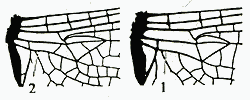
hind wing with 2 cubito-anal crossveins
with 1 such crossvein |
Somatochlora 31
29d
|
| 29d | black abdomen 2x(male) to 3x(female) as wide at end as at waist;
male with white abdominal ring segment 2 and sometimes 3, green eyes; female yellow-brown
segments 1 and 2, brown eyes; 18May-21Jul | Dorocordulia libera
|
| metallic green with green eyes, abdomen only twice as wide at widest
point as at narrowest 24May-8Aug | Cordulia shurtleffi
|
| brown | Epitheca 30
|
| 30 | 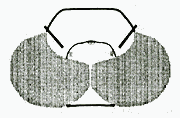 Epitheca (Tetragoneuria):
Epitheca (Tetragoneuria):
T-spot on frons clearly defined; male: upper appendages each with
small sharp spine projecting downward at about 2/5th of its length 8May-10Jul
T-spot indistinct or incomplete (usually base only) | E.spinigera
30a
|
| 30a | male: upper appendages with outer tip bent downward, with a bump
on upper side where slope begins, no crossbar on frons T-spot, female: vulva ends cylindrical
extending to margin of segment 9; stocky 6May-18Jul | E.canis
|
| large triangular basal spot rear wings only, row of yellow spots each
side of
abdomen; male: without such a bump, female: ends conical extending well beyond margin of
segment 9; hairy thorax 5Jun-18Jul | E.cynosura
|
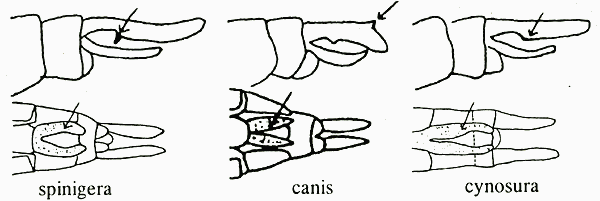
|
| 31 | 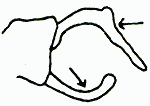 Somatochlora:
Somatochlora:
upper lip yellowish, often with black band across front border, face below suture mostly
yellow; brilliant bronze and green thorax, male: scythe-shaped appendages 1Jul-9Sep
|
Somatochlora tenebrosa
|
| upper lip black, if partly yellow with no such black band | 31a
|
| 31a | middle segments with clear rings of white about 1/10th their length;
one pale stripe/spot on side of metallic green thorax | 31b
|
| no such white rings | 31c
|
| 31b | thorax stripe barely distinguishable; male: lower appendage squared
off, nearly parallel to its widely forking tip, female: appendages viewed from side straightish below,
much more convex on upper margin (Tremblant 24Jun-4Sep) | S.cingulata
|
| yellow elongate spot each side of thorax; male: lower appendage
elongate-triangular, strongly tapering to single upturned tip, female: appendages about equally
convex on upper and lower margins, 26Jun-1Sep | S.albicincta
|

|
| 31c | two side stripes on thorax | 31d
|
| only one such stripe; face blackish green with 3 yellow spots, thorax
metallic green with brown-violet markings 23May- 29Aug | S.franklini
|
| 31d | each thorax stripe represented by round spot; face blackish blue
6Jun-30Aug | S.minor
|
| these spots elongated | 31e
|
| 31e | first thorax stripe narrower and much longer than 2nd; face
brownish yellow with black markings on frons, lower lip black 18Jun-1Sep | S.walshi
|
| this stripe shorter, about 1/2 thorax height, usually narrower than
2nd | 31f
|

|
| 31f | both thorax stripes bright yellow and sharply defined | 31g
|
| these stripes dull yellow and ill-defined | 31h
|
| 31g | middle segments with pale spots at front bases; brown with metallic
sheen 27May-27Aug | S.forcipata
|
| these segments with no pale spots; yellowish face, barely visible yellow
bars on metallic green thorax with light brown hairs (Tremblant 8Jun-30Aug) | S.elongata
|
| 31h | male: upper appendages very hairy, tips recurved, female:
subgenital plate triangular in profile, taper pointed and erect; dark with patches of dark yellow, hairy thorax
(Tremblant 21Jun-15Sep) | S.williamsoni
|
| male: upper appendages not hairy, not recurved at tips, lower curved
upwards, female: subgenital plate broadly triangular, not erect; blackish face with some pale
yellow, hairy thorax 5Jun-11Jul | S.kennedyi
|
| male: upper appendages not hairy, not recurved at tips, lower not
curved upwards, female: subgenital plate cylindrical; segment 2 with single small pale spot each side,
little thorax hair (19Jul-30Aug) | S.incurvata
|

|


 Lestes: female
Lestes: female
 two spots on top back of head next to eye
two spots on top back of head next to eye










 Aeshna, male:
Aeshna, male:
 central thorax stripe 1 mm or less wide and bent in sharp Z; eye
seam little if any longer than occiput, greenish face, T-spot with crescent base (Tremblant
21Jun-14Sep)
central thorax stripe 1 mm or less wide and bent in sharp Z; eye
seam little if any longer than occiput, greenish face, T-spot with crescent base (Tremblant
21Jun-14Sep)



 Ophiogomphus: male
Ophiogomphus: male










 Libellulidae:
Libellulidae:
 triple-length vacant space under stigma; (Lanark 11Jun-30Sep)
triple-length vacant space under stigma; (Lanark 11Jun-30Sep) 




 wing veins reddish, overall brownish red; male: hamuli forked for
about 1/4 visible length, rear branch 4 times as stout as inner, face cherry red with clear black line
bottom quarter of lower lip; 21Jun-18Sep
wing veins reddish, overall brownish red; male: hamuli forked for
about 1/4 visible length, rear branch 4 times as stout as inner, face cherry red with clear black line
bottom quarter of lower lip; 21Jun-18Sep


 Epitheca (Tetragoneuria):
Epitheca (Tetragoneuria):

 Somatochlora:
Somatochlora:


